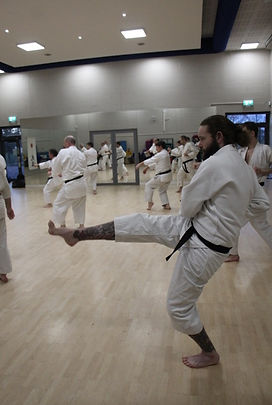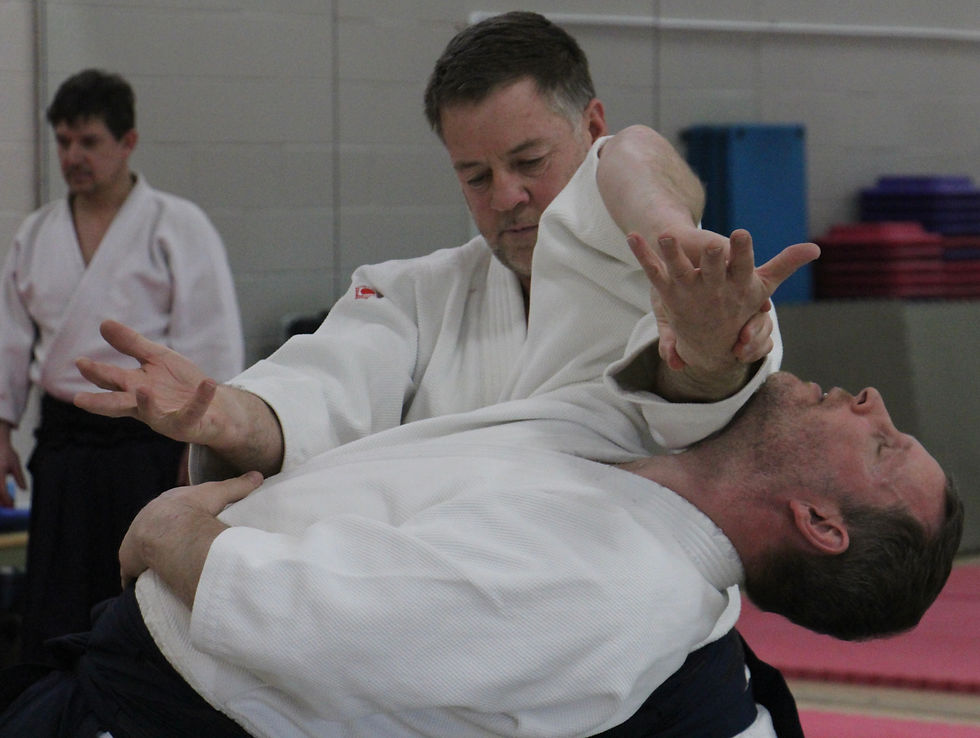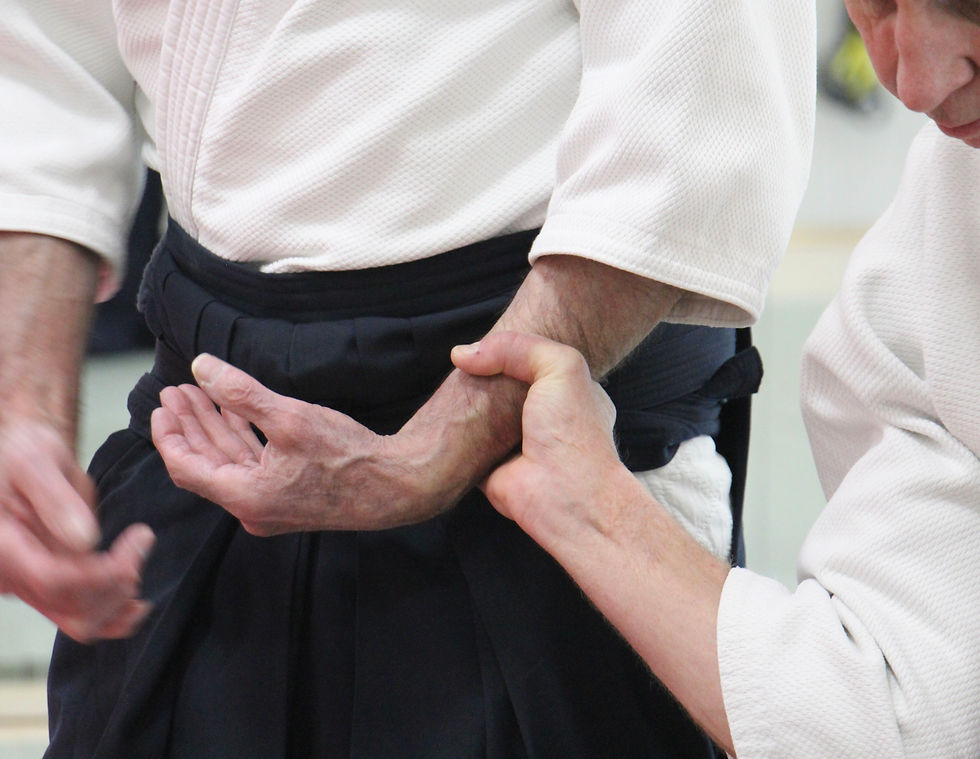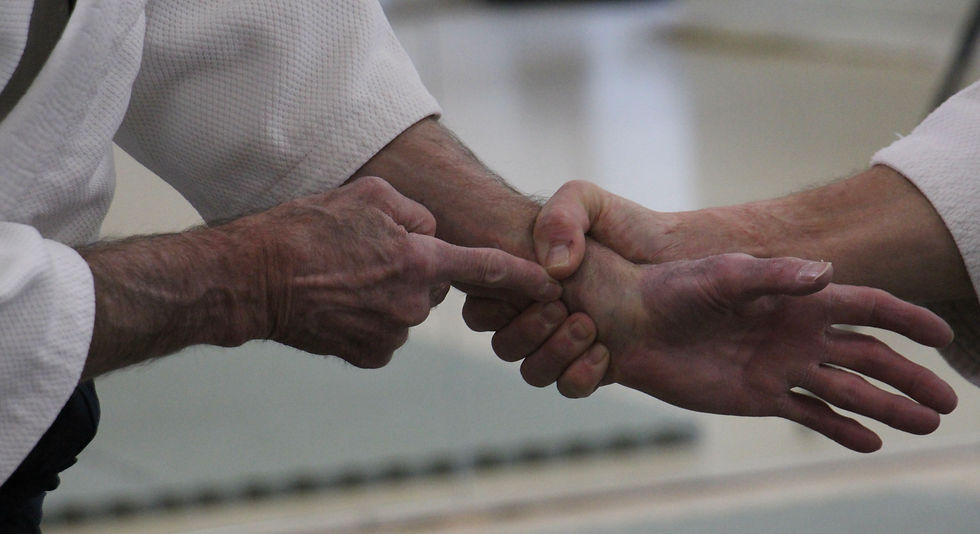WORKSHOPS
DECEMBER WORKSHOP
Budokan Karate
We missed our workshop in 2019 but at last we were able to host it at the Lymington Dojo on Saturday 4 December.
Thank you to those Budokan stalwarts who made it from Norwich, Shropshire, Sussex and London to come and join the locals for a workshop that focussed entirely on the fundamentals of our Karate.
Budokan has a proud history, legacy and lineage going back 60 years.
It has an impressive Black Belt Register, of over 200 people of which the majority come from the UK.
Budokan has spawned over 70 Dojo in various countries and consequently a large number of Sensei too over the years.
There are two additional elements both close to my heart that Budokan is also well known and respected for.
The first is our mantra - “Strong in Had - Kind in Heart” - “Kokoro ni - Tsuyoi te”.
The Japanese kanji for this will appear on all future Mon.
The other is just as important and that is our reputation for high standards of technical competence.
As the first SHO (as in Shodan or First Dan) or Founding Sensei and Chief Instructor, here in the UK, I take it upon myself to be the Guardian of technical competence at all levels across all Budokan Dojo.
All Budokan Teachers and Instructors should be teaching the same fundamental and basic techniques in the "Budokan Way'.
And all Budokan Black Belts know this way to be the "rigorous mental and physical training towards self-realisation in the tradition of Zen Buddhism".

Alex and Tony working on their Ananko basics.

Will B doing MaKeri during Ananko
THE FUNDAMENTALS OF BASICS IN KATA
BREATHING - Kokyu - The Power of Co-ordinated Breathing
STANCES - DaChi - Right Length - Right Width - Right Angle
POSTURE - Shisei - Upright - Head Balanced - Eyes and Shoulders level
MOVEMENT - Balance - Rotation - Stillness
POWER - Stopping, Starting and Release
GLIDE WALKING - TsugiAshi - Smoothness from Point to Point
JANUARY WORKSHOP









Budokan Aikido
We practise the aikido that emerged from the Aikikai in japan in the mid to late sixties.
Chiba Sensei was chosen to bring it to theUK against his wishes.
His brief was basically to beef up the aikido community here.
And that is exactly what he did do.
The style of Aikido at the Aikikai today has little resemblance to Chiba’s aikido at all.
And with the emergence of all of the other styles of Aikido such as Yoshinkan, Tomiki, Ki Aikido to name a few - Chiba chose to refer to his Aikido as that closest to the original Aikido of the Founder and called it Traditional Aikido.
And that is closest to the Aikido that we practice today and we retain the same name.
Because here at Budokan we practice all of our disciplines in the same spirit of Budo that Chiba endorsed and that has become part of an already existing hallmark of Budokan.
When Chiba went to live in the US, Budokan came under the influence and flair of the technically minimalist and highly effective Aikido of Tamura Sensei.
Both contributed to what we refer to today as the “Budokan Way”.
KokyuNage and the Art of Ukemi
Kokyunage are generally described as breathing projections and so they are to be practised with breathing in both mind and body.
That is coordinated and synchronised in both mind and body.
So the practice of Kokyu Nage begins to be taught using the Kgeki Ho - what are generally referred to as the entire range of “attacks” used in aikido.
Many students struggle with the idea that Ukemi in Kokyu Nage is no longer the response to the feeling of pain but the conscious choice to synchronise pure action in role play,
Only pure action takes place
One executes the action - the other takes ukemi.
As pure action that requires blending into the flow of the technique and becoming a part of it.
In other words there is no "attack" and no "defence".
Which is completely alien to early stage aikidoka.
Whilst taking ukemi is an essential and important part of the ability to become skilful in the practice of Kokyu Nage, there are however a few things that are more important to get right first.
Breathing
It is a basically simple premise -
Breath in when receiving and breath out when projecting.
Perception and Timing
Students don’t naturally perceive potential danger in the dojo.
But if you create the perception of dnager approaching and act accordingly you will move more smoothly and more importantly, at the right time.
Maai
Part of this perception is to establish the right distance at all times in an ever changing scenario. to limit the danger but more importantly to occupy the exact space at the right time.
Sabaki
And this is done using Sabaki - your angle of movement - particularly Irimi.
And Ushiro Tenkan - especially when you need space - quickly.